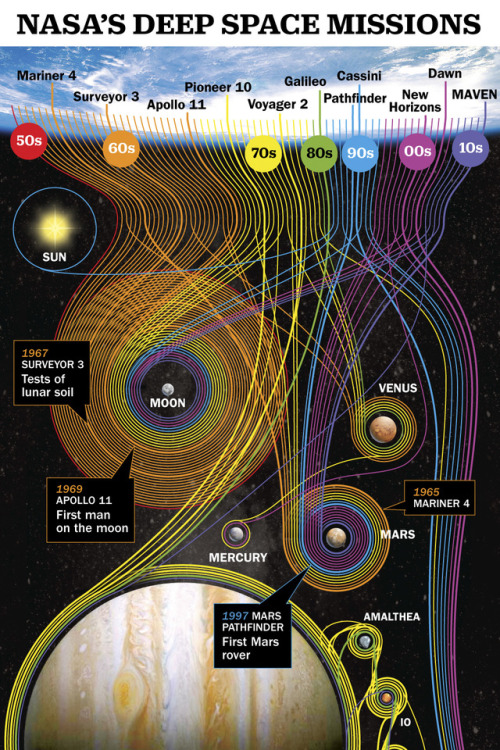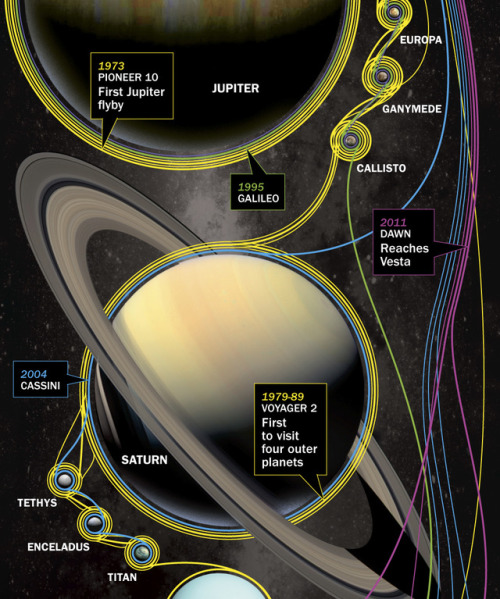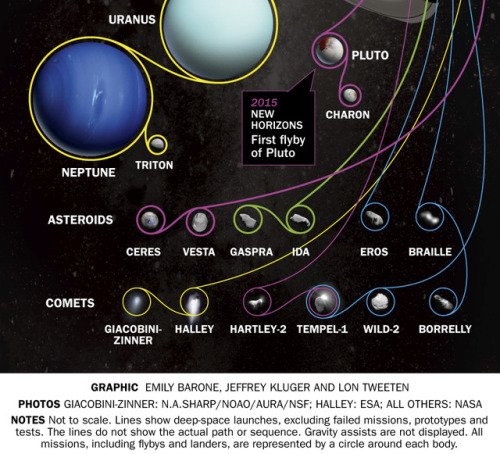Io And Jupiter.

Io and Jupiter.
More Posts from Fillthevoid-with-space and Others
Raising the bar for antimatter exploration
CERN - European Organization for Nuclear Research logo. March 18, 2017 The absence of antimatter in the universe is a long-standing jigsaw puzzle in physics. Many experiments have been exploring this question by finding asymmetries between particles and their antimatter counterparts. GBAR (Gravitational Behaviour of Antihydrogen at Rest), a new experiment at CERN, is preparing to explore one aspect of this puzzle – what is the effect of gravity on antimatter? While theories exist as to whether antimatter will behave like matter or not, a definitive experimental result is still missing.
Image above: Installation of the GBAR linac in its shielding bunker. The electrons accelerated to 10 MeV toward a target will produce the positrons that are necessary to form antihydrogen with the antiprotons coming from the ELENA decelerator. (Image: Max Brice/CERN). GBAR will measure the effect of gravity on antihydrogen atoms. Located in the Antiproton Decelerator (AD) hall, GBAR is the first of five experiments that will be connected to the new ELENA deceleration ring. On 1 March, the first component of the experiment was installed – a linear accelerator (linac). In sharp contrast to the LHC’s chain of big accelerators and fast particles, the AD world of antimatter is small and its particles are as slow as they come. The GBAR linac is only 1.2 metres long and it will be used to create positrons, the antimatter equivalent of electrons. The experiment will use antiprotons supplied by ELENA and positrons created by the linac to produce antihydrogen ions. They consist of one antiproton and two positrons, and their positive charge makes them significantly easier to manipulate. With the help of lasers, their velocity will be reduced to half a metre per second. This will allow them to be directed to a fixed point. Then, trapped by an electric field, one of their positrons will be removed with a laser, which will make them neutral again. The only force acting on them at this point will be gravity and they will be free to make a 20-centimetre fall, during which researchers will observe their behaviour. The results might turn out to be very exciting. As the spokesperson of GBAR, Patrice Pérez, explains: “Einstein’s Equivalence Principle states that the trajectory of a particle is independent of its composition and internal structure when it is only submitted to gravitational forces. If we find out that gravity has a different effect on antimatter, this would mean that we still have a lot to learn about the universe.” Five other experiments are based at the Antiproton Decelerator, two of which – AEGIS and ALPHA – are also studying the effect of gravity on antimatter. Note: CERN, the European Organization for Nuclear Research, is one of the world’s largest and most respected centres for scientific research. Its business is fundamental physics, finding out what the Universe is made of and how it works. At CERN, the world’s largest and most complex scientific instruments are used to study the basic constituents of matter — the fundamental particles. By studying what happens when these particles collide, physicists learn about the laws of Nature. The instruments used at CERN are particle accelerators and detectors. Accelerators boost beams of particles to high energies before they are made to collide with each other or with stationary targets. Detectors observe and record the results of these collisions. Founded in 1954, the CERN Laboratory sits astride the Franco–Swiss border near Geneva. It was one of Europe’s first joint ventures and now has 22 Member States. Related links: GBAR (Gravitational Behaviour of Antihydrogen at Rest): https://gbar.web.cern.ch/GBAR/public/index.html Antiproton Decelerator (AD): https://home.cern/about/accelerators/antiproton-decelerator ELENA: http://home.cern/about/updates/2016/11/new-ring-slow-down-antimatter linear accelerator (linac): http://home.cern/tags/linear-accelerator AEGIS: http://home.cern/about/experiments/aegis ALPHA: https://home.cern/about/experiments/alpha For more information about European Organization for Nuclear Research (CERN), Visit: http://home.cern/ Image (mentioned), Text, Credits: CERN/Iva Raynova. Greetings, Orbiter.ch Full article

SpaceX SES-10 Mission successfully Launch
SpaceX - Falcon 9 / SES-10 Mission patch. March 31, 2017
Falcon 9 carrying SES-10 satellite launch
SpaceX took a step into the future Thursday as it reused – for the first time – a recovered first stage of a previously-flown Falcon 9 rocket. Thursday’s mission, carrying the SES-10 communications satellite, lifted off from Pad 39A at Florida’s Kennedy Space Center Thursday 30 March at 18:27 local time (22:27 UTC) and once again landed the booster.
Falcon 9 launch of SES-10
Thursday’s mission made use Falcon 9 the second orbit-capable rocket – after the Space Shuttle – to achieve partial reusability. The Falcon 9 flew from Launch Complex 39A at the Kennedy Space Center, the same pad from which the Shuttle began eighty-two of its missions, including its first and final flights. Reusability has long been a key objective for SpaceX. Making the company’s first launch in March 2006, the small Falcon 1 vehicle carried a parachute system intended to bring its spent first stage back to Earth.
Falcon 9 first stage landed on drone barge
SpaceX’s Falcon 9 rocket deliver SES-10, a commercial communications satellite for SES, to a Geostationary Transfer Orbit (GTO). SES is a world-leading satellite operator, providing reliable and secure satellite communications solutions across the globe.
SES-10 satellite
The SES-10 mission mark a historic milestone on the road to full and rapid reusability as the world’s first reflight of an orbital class rocket. Falcon 9’s first stage for the SES-10 mission previously supported the successful CRS-8 mission in April 2016. For more information about SpaceX, visit: http://www.spacex.com/ Images, Video, Text, Credits: SpaceX/SES. Greetings, Orbiter.ch Full article
This is so sweet! What a nice way to spend a Saturday night.
Make Sure You Observe the Moon on October 20
On Saturday, October 20, NASA will host the ninth annual International Observe the Moon Night. One day each year, everyone on Earth is invited to observe and learn about the Moon together, and to celebrate the cultural and personal connections we all have with our nearest celestial neighbor.
There are a number of ways to celebrate. You can attend an event, host your own, or just look up! Here are 10 of our favorite ways to observe the Moon:
1. Look up

Image credit: NASA’s Scientific Visualization Studio/Ernie Wright
The simplest way to observe the Moon is simply to look up. The Moon is the brightest object in our night sky, the second brightest in our daytime sky and can be seen from all around the world — from the remote and dark Atacama Desert in Chile to the brightly lit streets of Tokyo. On October 20, the near side of the Moon, or the side facing Earth, will be about 80 percent illuminated, rising in the early evening.
See the Moon phase on October 20 or any other day of the year!
2. Peer through a telescope or binoculars

The Moon and Venus are great targets for binoculars. Image Credit: NASA/Bill Dunford
With some magnification help, you will be able to focus in on specific features on the Moon, like the Sea of Tranquility or the bright Copernicus Crater. Download our Moon maps for some guided observing on Saturday.
3. Photograph the Moon

Image credit: NASA/GSFC/ASU
Our Lunar Reconnaissance Orbiter (LRO) has taken more than 20 million images of the Moon, mapping it in stunning detail. You can see featured, captioned images on LRO’s camera website, like the one of Montes Carpatus seen here. And, of course, you can take your own photos from Earth. Check out our tips on photographing the Moon!
4. Take a virtual field trip

Image credit: NASA/JPL-Caltech
Plan a lunar hike with Moontrek. Moontrek is an interactive Moon map made using NASA data from our lunar spacecraft. Fly anywhere you’d like on the Moon, calculate the distance or the elevation of a mountain to plan your lunar hike, or layer attributes of the lunar surface and temperature. If you have a virtual reality headset, you can experience Moontrek in 3D.
5. Touch the topography

Image credit: NASA GSFC/Jacob Richardson
Observe the Moon through touch! If you have access to a 3D printer, you can peruse our library of 3D models and lunar landscapes. This model of the Apollo 11 landing site created by NASA scientist Jacob Richardson, is derived from LRO’s topographic data. Near the center, you can actually feel a tiny dot where astronauts Neil Armstrong and Buzz Aldrin left the Lunar Descent Module.
6. Make Moon art

Image credit: LPI/Andy Shaner
Enjoy artwork of the Moon and create your own! For messy fun, lunar crater paintings demonstrate how the lunar surface changes due to consistent meteorite impacts.
7. Relax on your couch

Image credit: NASA’s Scientific Visualization Studio/Ernie Wright
There are many movies that feature our nearest neighbor, from A Voyage to the Moon by George Melies, to Apollo 13, to the newly released First Man. You can also spend your evening with our lunar playlist on YouTube or this video gallery, learning about the Moon’s role in eclipses, looking at the Moon phases from the far side, and seeing the latest science portrayed in super high resolution. You’ll impress all of your friends with your knowledge of supermoons.
8. Listen to the Moon
Video credit: NASA’s Scientific Visualization Studio/Ernie Wright
Make a playlist of Moon songs. For inspiration, check out this list of lunar tunes. We also recommend LRO’s official music video, The Moon and More, featuring Javier Colon, season 1 winner of NBC’s “The Voice.” Or you can just watch this video featuring “Clair de Lune,” by French composer Claude Debussy, over and over.
9. See the Moon through the eyes of a spacecraft

Image credit: NASA/GSFC/MIT
Visible light is just one tool that we use to explore our universe. Our spacecraft contain many different types of instruments to analyze the Moon’s composition and environment. Review the Moon’s gravity field with data from the GRAIL spacecraft or decipher the maze of this slope map from the laser altimeter onboard LRO. This collection from LRO features images of the Moon’s temperature and topography. You can learn more about our different missions to explore the Moon here.
10. Continue your observations throughout the year

Image credit: NASA’s Scientific Visualization Studio/Ernie Wright
An important part of observing the Moon is to see how it changes over time. International Observe the Moon Night is the perfect time to start a Moon journal. See how the shape of the Moon changes over the course of a month, and keep track of where and what time it rises and sets. Observe the Moon all year long with these tools and techniques!
However you choose to celebrate International Observe the Moon Night, we want to hear about it! Register your participation and share your experiences on social media with #ObserveTheMoon or on our Facebook page. Happy observing!
Make sure to follow us on Tumblr for your regular dose of space: http://nasa.tumblr.com.
-
 the-promised-wlan liked this · 9 months ago
the-promised-wlan liked this · 9 months ago -
 vidapura2017 reblogged this · 1 year ago
vidapura2017 reblogged this · 1 year ago -
 jazz-improvisation liked this · 1 year ago
jazz-improvisation liked this · 1 year ago -
 zippocreed501 liked this · 1 year ago
zippocreed501 liked this · 1 year ago -
 lafortunadevivir reblogged this · 1 year ago
lafortunadevivir reblogged this · 1 year ago -
 lafortunadevivir liked this · 1 year ago
lafortunadevivir liked this · 1 year ago -
 srtrementine reblogged this · 1 year ago
srtrementine reblogged this · 1 year ago -
 srtrementine liked this · 1 year ago
srtrementine liked this · 1 year ago -
 gameover77world liked this · 1 year ago
gameover77world liked this · 1 year ago -
 gazoo765 reblogged this · 2 years ago
gazoo765 reblogged this · 2 years ago -
 gazoo765 liked this · 2 years ago
gazoo765 liked this · 2 years ago -
 mr-pharma-0 liked this · 4 years ago
mr-pharma-0 liked this · 4 years ago -
 daowa-maad reblogged this · 4 years ago
daowa-maad reblogged this · 4 years ago -
 xepjail liked this · 4 years ago
xepjail liked this · 4 years ago -
 joedelaplaine reblogged this · 4 years ago
joedelaplaine reblogged this · 4 years ago -
 joedelaplaine liked this · 4 years ago
joedelaplaine liked this · 4 years ago -
 violeentdelights liked this · 4 years ago
violeentdelights liked this · 4 years ago -
 violeentdelights reblogged this · 4 years ago
violeentdelights reblogged this · 4 years ago -
 dropdead61 liked this · 4 years ago
dropdead61 liked this · 4 years ago -
 namzadias reblogged this · 4 years ago
namzadias reblogged this · 4 years ago -
 namzadias liked this · 4 years ago
namzadias liked this · 4 years ago -
 malefica67 liked this · 4 years ago
malefica67 liked this · 4 years ago -
 simolegheg75 liked this · 4 years ago
simolegheg75 liked this · 4 years ago -
 stumm13 reblogged this · 4 years ago
stumm13 reblogged this · 4 years ago -
 stumm13 liked this · 4 years ago
stumm13 liked this · 4 years ago -
 pocmonk liked this · 4 years ago
pocmonk liked this · 4 years ago -
 lovelybottommam liked this · 4 years ago
lovelybottommam liked this · 4 years ago -
 okumalright reblogged this · 4 years ago
okumalright reblogged this · 4 years ago -
 okumalright liked this · 4 years ago
okumalright liked this · 4 years ago -
 oldvision reblogged this · 4 years ago
oldvision reblogged this · 4 years ago -
 sirblakeney reblogged this · 5 years ago
sirblakeney reblogged this · 5 years ago -
 wordboy1 liked this · 5 years ago
wordboy1 liked this · 5 years ago -
 selectordk-blog liked this · 5 years ago
selectordk-blog liked this · 5 years ago -
 pineapplemarble-blog reblogged this · 5 years ago
pineapplemarble-blog reblogged this · 5 years ago -
 wannamoreofyou liked this · 5 years ago
wannamoreofyou liked this · 5 years ago -
 rockum liked this · 5 years ago
rockum liked this · 5 years ago -
 7t7yuc-blog liked this · 5 years ago
7t7yuc-blog liked this · 5 years ago -
 sasso liked this · 5 years ago
sasso liked this · 5 years ago -
 blu27nature reblogged this · 5 years ago
blu27nature reblogged this · 5 years ago -
 tobesolonley01 liked this · 6 years ago
tobesolonley01 liked this · 6 years ago
A podcast project to fill the space in my heart and my time that used to be filled with academic research. In 2018, that space gets filled with... MORE SPACE! Cheerfully researched, painstakingly edited, informal as hell, definitely worth everyone's time.
243 posts











![The Science Of Interstellar - Black Hole [YouTube Video]](https://64.media.tumblr.com/a1cf99c4f65fd1eae0d88d0485c9f109/tumblr_nfogd8kIyF1qb6kd0o1_250.gif)
![The Science Of Interstellar - Black Hole [YouTube Video]](https://64.media.tumblr.com/e1f24da4d0364bc2ca8dbb2c0bdfea28/tumblr_nfogd8kIyF1qb6kd0o3_250.gif)
![The Science Of Interstellar - Black Hole [YouTube Video]](https://64.media.tumblr.com/821ab338f5c9fd5c61cc1af57318cbaf/tumblr_nfogd8kIyF1qb6kd0o4_250.gif)
![The Science Of Interstellar - Black Hole [YouTube Video]](https://64.media.tumblr.com/f40b0668bb5fc168df25afc88b7bdfe5/tumblr_nfogd8kIyF1qb6kd0o5_250.gif)
![The Science Of Interstellar - Black Hole [YouTube Video]](https://64.media.tumblr.com/04b808634cb4e90392903fc5c65e1d79/tumblr_nfogd8kIyF1qb6kd0o6_250.gif)
![The Science Of Interstellar - Black Hole [YouTube Video]](https://64.media.tumblr.com/b45ee46e319ac5ffc37f82f071b2dac3/tumblr_nfogd8kIyF1qb6kd0o2_250.gif)



